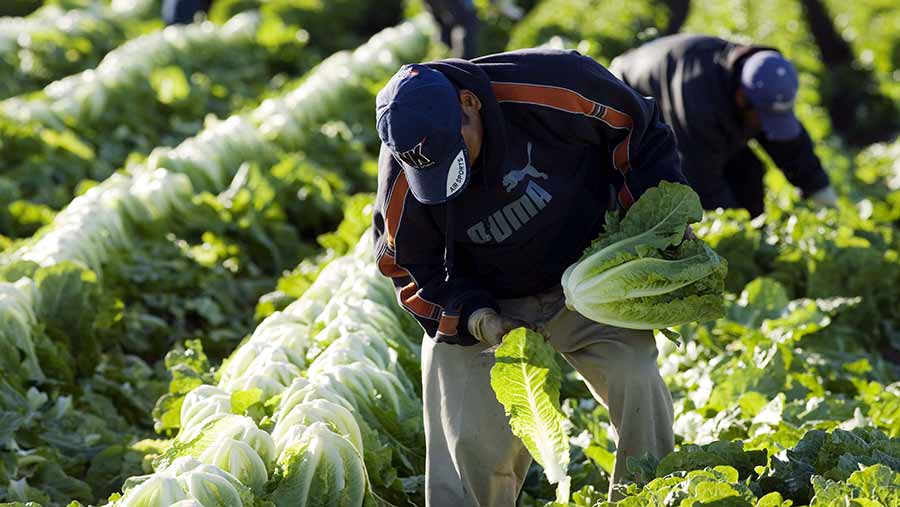6 reasons national living wage could devastate horticulture
 © J Kurtz/Keystone USE/Rex Shutterstock
© J Kurtz/Keystone USE/Rex Shutterstock The national living wage (NLW) could make many horticulture businesses completely unprofitable within just three years, according to a study into the effects of the wage rise on agriculture.
The independent report by Andersons, commissioned by the NFU, concludes that the rise in employment costs resulting from the introduction of the NLW will be a huge problem to the sector.
The union will use the report to show buyers they will need to absorb some of the extra costs and to lobby government to delay the introduction of the new arrangements to allow the industry time to adapt.
See also: Scottish grower profits could be eliminated by wage rise
What is the national living wage?
The national living wage will be introduced in April 2016 and apply to workers aged 25 and over. The initial rate will be £7.20/hr but it is predicted to rise to around £9.35/hour by 2020.
The NFU also wants to see the reintroduction of a seasonal agricultural workers scheme for student workers from around the world.
The six key issues for the horticulture sector relating to the NLW are identified as:
1. Labour is massive part of total costs
Horticulture businesses employ high numbers of seasonal staff during the year, which means they are very exposed to changes in wage costs.
The sector employs about 37,000 people in England on a permanent basis and another 40,000 seasonal workers every year.
Typically, labour accounts for 35-60% of turnover in a horticulture business and can be £20,000/ha to £50,000/ha for the most labour-intensive crops.
2. Reducing labour in the short-term is not viable
The horticulture industry may have been at the forefront of adopting new technology, but there is still a massive requirement for manpower.
Harvesting of many root crops is mechanised, but these crops often have a significant labour requirement at the grading and packing end of the process.
Many horticultural crops such as soft fruits and leafy salads are still reliant on hand harvesting.
Widespread mechanisation of these crops is still at least 10 years away and will only be possible if businesses have the money to invest in the technology anyway, says the report.
3. Profit levels are already low
Farm profitability for growers of fruit, vegetables, flowers and plants remains low because of downward price pressures and increasing input costs.
Profit levels are typically 2-7% of turnover, but the risks are also high as horticulture crops can be expensive to grow.
Official figures show that in 2014-15 20% of horticulture businesses failed to make any profit at all.
The Andersons report forecast the profits of three “model” businesses employing 80, 250 and 450 workers with turnovers of £1.25m, £4.25m and £9m respectively.
Assuming a profit level of 5%, the calculations show the additional costs of the NLW are equivalent to 129-158% of current business profit.
4. The wage increase is unprecedented
Overall, Andersons says the introduction of the NLW is set to increase the cost of seasonal wages for horticultural businesses in the UK by 35% over the period 2016-2021.
This is equivalent to an average annual rate of wage inflation of just under 7% a year.
While there have been significant annual increases in the national minimum wage (NMW) in the past, for example 10.81% in 2001, 7.14% in 2003 and 7.78% in 2004, the report says the scale of the increase faced under the NLW is greater than any five year period under the NMW (average previous five years of NMW was a 2.47% increase).
5. Employers’ national insurance costs compound the problem
The report points out that the impact of the NLW is made worse by the effects of employers national insurance contributions (NICs).
The NFU is calling for there to be no requirement for employers to pay NICs, or auto-enrol people into a pension scheme, for seasonal workers.
While this would help to reduce the wage bill, Andersons projects that even without the need to pay NICs the additional costs of the NLW alone would be equivalent to 89-109% of current business profit.
6. Lower labour costs elsewhere in the world
British growers are facing stiff competition from imports and there are already record levels of imported fruit and vegetables on supermarket shelves.
One factor is the pound remains steadily strong against the euro, but another is that minimum wage rates in the majority of EU countries are lower than in the UK.
The report suggest that when the NLW is introduced in April 2016, UK wages rates will be the second highest in Europe, with only Luxembourg paying more to its workers.
The UK imports most fruit and vegetables from Spain and the minimum hourly rate there is €3.93 (£2.84), compared with €9.03 (£6.70) in the UK.
Andersons says while other countries do have higher employer tax costs than the UK, it is still likely that the NLW will see domestic supply replaced by imported produce from places with lower labour costs.
